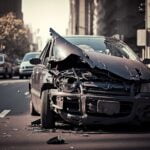How to Avoid the 7 Most Common Motorcycle Crashes

In 2017, over 1000 crashes involved motorcycles and nearly 60 motorcyclists lost their lives in fatal collisions. That’s a massive 12% of all crash-related deaths in Kansas. The figures give a clear indication of how common motorcycle accidents are and the higher risks of operating a motorcycle.
The majority of motorcyclists consider other vehicle operators to be the greatest threat to their safety while on the road. Be that as it may, the fact is that evasive maneuvers can go a long way in helping riders to stay out of harms ways.
To execute a defensive maneuver, you must know what hazards await you and where the danger lurks. So, continue reading to learn about the 7 most common motorcycle crashes and how to avoid these scenarios.
1. The very dangerous head-on collisions
Most fatal motorcycle wrecks are head-on collisions, and understandably so. It’s understandable that a motorcycle, which typically weighs less than one quarter of a sedan, and its operator, suffers the maximum damage and losses.
How do these collisions occur?
Most such crashes occur because the car driver fails to notice/see the motorcyclist in time. So, it would be fair to assume that either a blind spot or distraction or inebriation is a part of such collisions.
Simply put, these incidents happen before the other motorist has had a chance to take corrective action, which explains the higher rate of fatality. So, keep an eye out for signs of driver distraction such as:
- Sudden and unrequired swerving.
- Vehicles that are going well above the speed limit.
- Unsafe overtaking.
- Frequent and unwarranted lane changes.
How do you prevent head-on crashes?
The best way to prevent a head-on collision is to keep away from oncoming traffic. So, stay away from the left lane and stay as far to the right as possible.
- On a four lane road, this would mean staying on the right-most lane.
- On a two lane road, this would mean riding on the outside of the lane.
With both these defensive techniques, you get enough room to swerve to the right to avoid a car speeding towards you. And while you are staying to the right, also slow down to a speed that will give you more response time. Typically, slowing by about 20-30 mph proves to be a life-saving move in such scenarios.
2. The dreaded left turn crash
A car turning left in front of the motorcyclists is one of the most common causes of wrecks involving motorcycles. Almost 55% of all crossing path collisions and nearly 45% of all motorcycle wrecks are caused by a car turning left.
How do these collisions occur?
These crashes are attributed to “I just did not see the smaller vehicle” syndrome. Typically, the turning motorist inadvertently misses the motorcycle and strikes the smaller vehicle, which is on a straight path.
How do you prevent the left turn wrecks?
Because an error on the part of the motorist results in all left turn crashes, including those involving cars, the only thing you can do is anticipate the other driver’s move before it turns into a problem for you. So, keep an eye out for any tell-tale signs of an impending left turn such as:
- A car that slows down or stops at the intersection.
- A gap in between the cars ahead that provides enough room for a vehicle to make a turn.
- Movement of the front wheels to the left.
- Obstructions that will put you in the blind spot of the turning motorist.
The safest approach would be to slow down before you get to the trouble spots like intersections, turn lanes and roadways with a lot of obstructions. Also be aware of the vehicles to your side and those behind you.
If you brake suddenly to stop yourself from crashing into a turning car and get rear-ended, you still end up with injuries. This is the same for applying brakes at full power on slick surfaces. So, spatial and surface awareness are of utmost importance.
That said, if you do find yourself hurtling towards a turning vehicle, shed as much speed as you can. Even a decrease of 10-20 mph can mean the difference between life threatening injuries or death.
3. The rear end collisions
A fender-bender may not make a big difference to a car, but when a motorcycle is rear-ended by a car, even one that is doing a dismal 20 mph, the results can be catastrophic. Unfortunately, the motorcyclists has just as high a risk of sustaining serious injuries when he rear-ends a car.
How do rear end collisions occur?
When the motorcycle is struck from behind, the car driver is usually distracted or impaired or going so fast that they cannot stop the car from plowing into the small vehicle ahead.
When the motorcycle does the striking, speed, not maintaining safe distance and the car in front coming to a sudden halt are typically the causes of the crash.
To stop yourself from rear ending a car, slow down and give your vehicle and yourself the safety margin needed to stop before you go crashing into the trunk of the car in front of you.
4. The lane change crashes
A lot of bikers get wiped out by motorists who are changing lanes and are unaware of the presence of other vehicles that they simply don’t spot the motorcyclist. In fact, nearly 35% of all motorcycle wrecks are attributed to right of way violations. Almost 10% of all multi-vehicle collisions on American roads occur because of unsafe lane changing.
How do lane changing collisions occur?
The factor that gives motorcycles their fun quotient and their power also makes them vulnerable. The smaller size of these two-wheeled mean machines makes it so easy to get into the blind spot of even regular passenger cars. So just imagine what happens when the other vehicle is a heavy truck or trailer.
Add to this the fact that most motorist are psychologically programmed to only watch for other cars, and it is easy to understand why so many motorcyclists bear the brunt of unsafe lane changes.
How can you prevent lane changing crashes?
- Get noticed: Know where the blind spots are and get out of these no-visibility zones as fast as you can. If you can’t see the driver in the mirrors of his car, rest assured he cannot see you either. Of course, there is no telling if the motorist has actually noticed you even if you are not in their blind spot.
- Be aware of situations where lane changing is frequent and common: High traffic situations in which one lane is moving faster than the others are the perfect setup for sudden and frequent lane changes. Everybody will want to go to the fast-moving lane and that should give you enough reason to stay away from it or exercise extreme caution if you intend to join it as well.
- Be on the lookout for indications of a lane change: An indicator is the most obvious sign, and all motorists should use it, but they don’t. So, look for other signs as well such as the wheels turning and the driver checking the mirrors before the lane change
5. The perils of lane splitting
According to a UC Berkeley study lane splitting is actually safe at certain speeds and helps to relieve traffic congestion. Yet, lane sharing only remains legal in California and Utah (lane filtering legal as of 2019). So, motorcyclists in Kansas cannot indulge in lane splitting, although they are allowed to ride two abreast in a single lane.
Simply put, other motorist are allowed to follow you in the same lane as long as they maintain safe distance, and you are not allowed to overtake a vehicle in your lane or ride in between lanes or adjacent rows of traffic.
How do lane splitting wrecks occur?
The first problem is the anti-lane splitting law, which creates a psychological barrier of sorts for other motorists. They are simply not expecting a biker to wiggle into the space between two cars.
The second problem is the space between two vehicles, which is usually around 4-6 feet (assuming the lane width to be 12 feet). So with a bike width of 2.5 feet from one handle bar to the other, you would have a mere 1- 1.5 feet clearance on both sides.
Among other things, the sheer shock of having a biker riding so close to the vehicle may cause the motorists to swerve. Also, no matter how good you are at handling your motorcycle, you do set the stakes very high with that low of margin for error.
Moreover, even in the study mentioned above, researchers found that lane splitting is safe only if the motorcyclists is doing less than 50 mph and maintains a speed differential of less than 15 mph.
How do you avoid lane splitting wrecks?
Simple, don’t barge in between lanes! Kansas laws give motorcyclists the right to the entire lane, so why not enjoy what is legally offered to you?
The most important thing to understand here is that lane splitting greatly increases your risk of a side impact crash, as a car changes lanes. And if you do get hurt in a collision while you were lane splitting, the blame for the mishap will squarely be placed on your shoulders. Which won’t bode well for your restitution claim!
6. Testing your riding skills while entering a corner
About 30% of all motorcycle collisions are single vehicle crashes and the majority of these occur when the rider turns a corner too fast. The big problem is that such crashes put the motorcyclists in the path of oncoming traffic. So, even if the fall does not create severe injuries, there is the very real risk of crashing into other cars or worse yet a vehicle inadvertently driving over the rider.
How do crashes occur when entering the corner?
Most single vehicle motorcycle crashes that are linked to misjudgment when taking a turn are attributed to:
- Going too fast.
- Hitting grass, gravel or sand as the rider enters the turn which lead to loss of traction.
Twisting roads with elevation changes pose a heightened risk of such crashes. On such roads, it can be hard to estimate how tight the turn is and to see what awaits you once you get past the bend.
How do you avoid crashes that occur when entering a turn?
- Be realistic about your abilities to handle speed: The slower you are, the more time you get to react and apply corrective measures when the unexpected happens. Only ride as fast as you can react and as far as you can see. This means if you are not 100% focused on the road or are a newbie rider, slowing down will be in your best interest.
- Use visual cues to gauge the road ahead: Roadway signs, telephone poles, milestones and even trees can help you to get a gist of what awaits on the other side of the blind crest. So, use these visual cues to guide your speed, direction and the lean angle.
- Make up for the excess speed: The best time to apply corrective action is before you enter the corner. So, brake earlier; that is before you enter the turn and use the same amount of brake force as you would when entering the corner at a slower speed.
7. Guess what goes into the making of the deadliest of motorcycle collisions?
Only about 2% of all motorbike wrecks are caused due to poor surface conditions. In contrast, a massive 30% crashes are attributed to speeding and another 30% plus result from drunk riding/driving.
Motorcycle collisions caused due to speeding or driving when intoxicated, whether they involve another vehicle or not, are known to cause injuries that are far more serious and life threatening than crashes in which these factors are not implicated.
The use of safety equipment, particularly a helmet, plays a large role in protecting riders in case of a crash. They reduce the risk of head injury by nearly 70% and that of death by almost 40%. Yet less than half of all riders involved in collisions are found to have their helmets on at the time of crash.
What is more shocking is that only about 10% of motorcycle riders who were involved in collisions across the country had insurance to cover their personal and property damage.
You must have guessed by now, that if riders who are found to be drunk or speeding at the time of the crash, don’t have a bright chance of claiming damages. Play it safe and don’t drive when drunk and don’t go over the speed limit.
Uninsured and seriously hurt: What do you do?
Kansas motorcycle riders do not get medical help from their PIP (Personal Injury Protection) coverage. Unlike cars, motorcycle owners are not mandatorily required to carry this form of coverage. So, even if your motorcycle is insured, PIP may not be a part of your policy.
Tragically, as hard as you may try and as careful as you are, sometimes wrecks happen for no fault of your own. Also, motorcycle collision injuries are often life altering if not life threatening.
And if you are hurt in such a crash, what do you do?
Get in contact with DeVaughn James! We have years of experience in handling personal injury claims for motorcycle riders. Our experienced attorneys will analyze your case and the circumstances that led to the crash.
We gather expert testimony and other crash related facts to ensure that we can establish and prove clear negligence/fault. More often than not, for motorcycle riders, this is the only way to seek compensation for the physical harm they have suffered.








